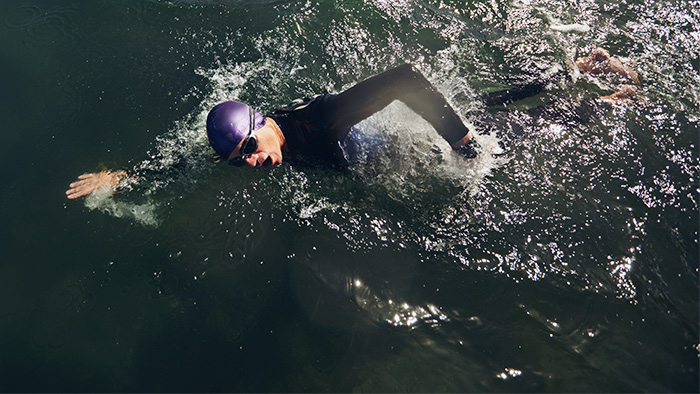Olympic distance simulation workouts and “big days” provide practice with race execution, offer fitness benefits and give you a very good idea of just how ready you are for race day.
Olympic distance simulation workouts should incorporate race-specific elements related to the event’s conditions: terrain, duration, intensity, fueling and hydration. The more specific you can make the details for these training days, the better off you’ll be.
The Strategy
An Olympic distance triathlon tests both your endurance and speed, so you need workouts that will allow you to work on both.
The workouts offered here can be done as stand alone sessions, or combine them for one big day of training. For best results, I recommend a big day of training to gauge overall race preparedness.
You can do one about eight weeks out from race day, and then another one four weeks out. Use the first session to inform any tweaks you want to make before the second session. Then, use the second session to dial in the details for your best race.
If you do this as a big day of training, make sure to set up a mock transition area before you start. Keep it as realistic as possible to race day as you can save valuable time by prepping for a speedy transition.
The Swim: Descending Open Water Sets
For these workouts it is best to find some open water in order to best simulate race conditions. However, if you don’t have access to open water you can do this workout in the pool too. Try adding in some laps without touching the wall to simulate open water, and also practice your sighting skills.
Swim easy for 10 minutes to warm up and acclimate to the water, just as you might on race day.
After you’ve warmed up, you will swim three sets, each one is five to seven minutes in duration. In between each set, tread water lightly for about 30 seconds before starting the next one. To begin the first set, start on the shoreline if your race has a beach start, or in the water if your race has an in-water start.
Remember: stay specific to race details!
Descending Open Water Set
Set #1
Take 20 to 30 hard strokes, and then settle into a race effort for the remaining duration. Most of us feel that spike of energy in the opening minutes of the swim, so the hard strokes will help you learn how to manage the surge and settle into race effort before you burn too many matches and fade off of race effort.
Set #2
Begin at race effort for about a minute, and then insert two to three intervals of 20 to 30 hard strokes, settling back into race effort for 20-30 strokes in between. After the third set, finish out the duration at race effort. This set will mimic the various surges that may happen throughout the swim, such as when you need to get out of a congested spot, throttle after a turn buoy, or speed up to stay on the feet of a swimmer ahead of you.
Set #3
Begin at race effort, and then gradually increase your effort for a total of seven minutes of swimming. This set helps you prepare for a strong finish to the swim.
To advance this workout, you can either:
- Increase the interval durations by one to two minutes.
- Add an additional interval that is similar in style to the second set. For example, 10 hard strokes followed by 10 easy strokes of swimming for a total of five minutes.
The Bike: Surges & Settle
For an Olympic distance triathlon, your best option is to practice running strong off the bike, and the best way to do this is with a brick workout. Ride 25 miles, followed by a 10K run at anywhere from 80 to 100 percent of FTP (85 to 95 percent lactate threshold heart rate), depending on the relationship between your bike and run strength, and your experience with the distance and the intensity.
However, within an Olympic race, there will be times when you have to surge your effort in an effort to pass, to catch up or to climb. This workout combines those changing elements, while bringing you back to your base race effort.
If you are doing this session as a standalone effort, then take the time to warm up for 15 minutes. If you are doing this session as part of a big day of training, then after the swim, take five minutes to get into a rhythm on the bike before moving into the main sets. If you plan to do a flying mount on race day—make sure to practice it!
Bike Surge Set
3 to 4 times through of:
- 10 minutes at race-specific effort. Make sure that the effort you expend is sustainable across all of the intervals. You can gradually add effort to each interval, but don’t fade by the last set.
- At the top of minutes two, five and eight, add in a 20-second sprint, then come back to race effort
- Five minutes easy spin at 50 percent of FTP
If you are doing this as a stand alone session, add a little more easy spinning to cool down. If doing this as a big day, then get ready to run immediately after the end of the last interval.
The Run: 10K Tempo Efforts
An Olympic triathlon 10K run is a mostly tempo effort that can descend closer into a threshold effort in the final miles. For this session, you will work at your estimated race effort, with short recoveries. This will give you a very good sense of what pace is sustainable come race day.
10K Tempo Effort Set
- 4 to 6 x 1 mile at a 10K pace/effort (For the first big day of training, I recommend starting with 4 x 1 miles)
- 90 to 120 seconds recovery (walk) in between each mile
At the end of these workouts, take note of what worked, what you want to change, and how you want to modify the strategy for race day. Adapt future training sessions to better dial in how you will approach the day and make sure to work on any limiters you uncovered in these sessions.
When it comes time to start, know that you did the work, and believe that you are ready. Good luck!


